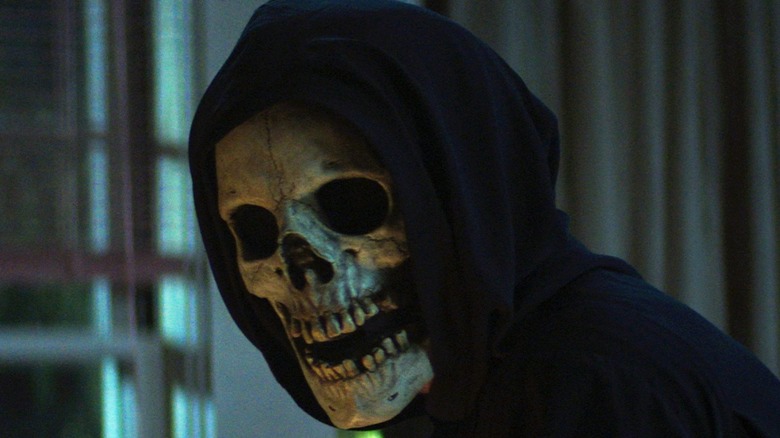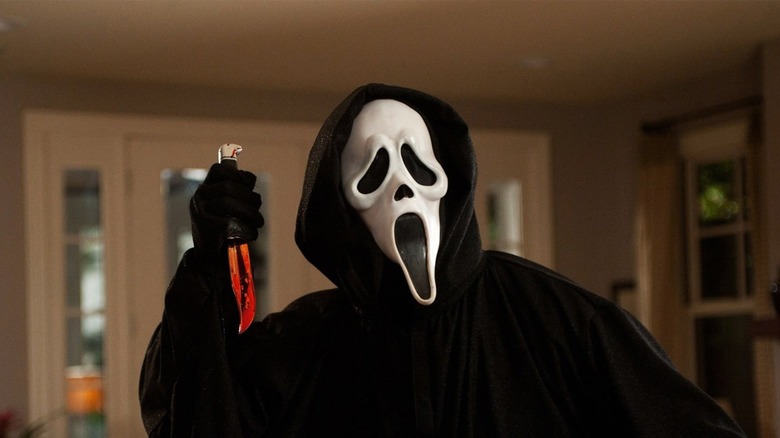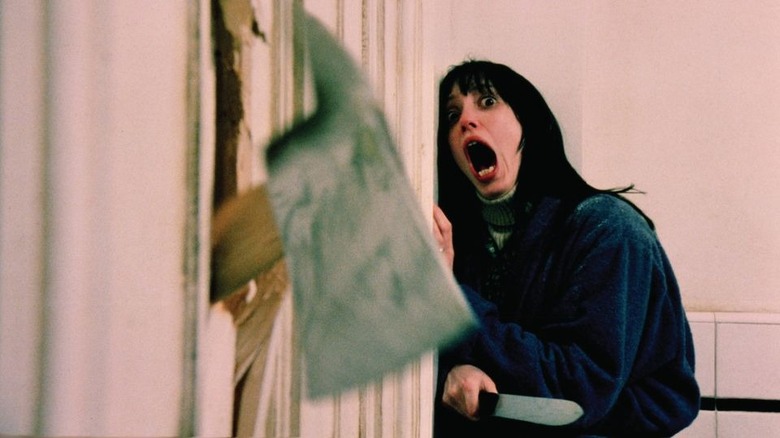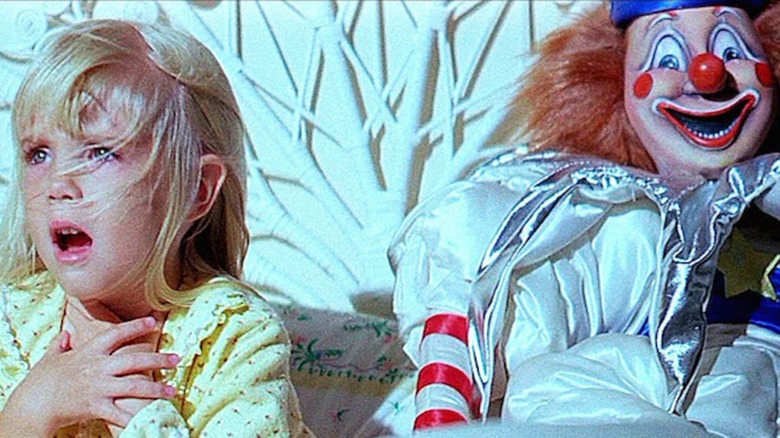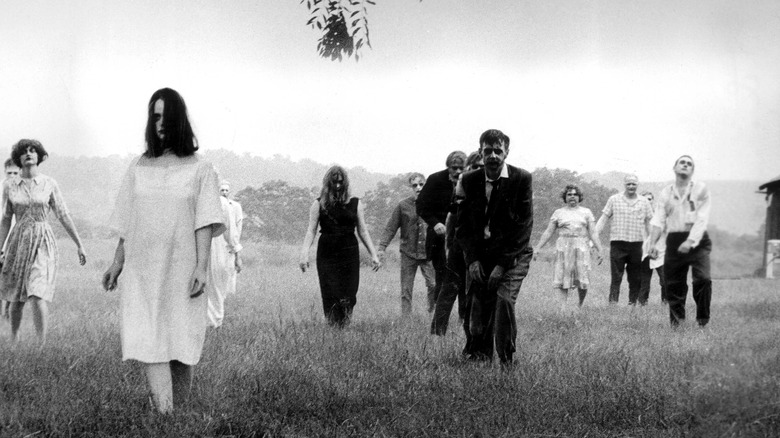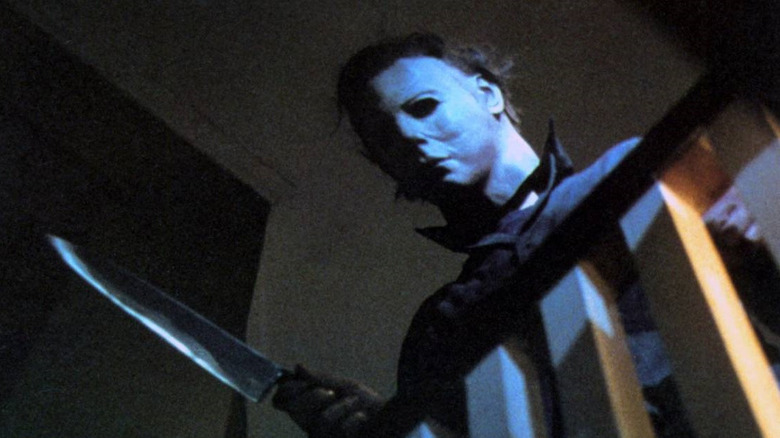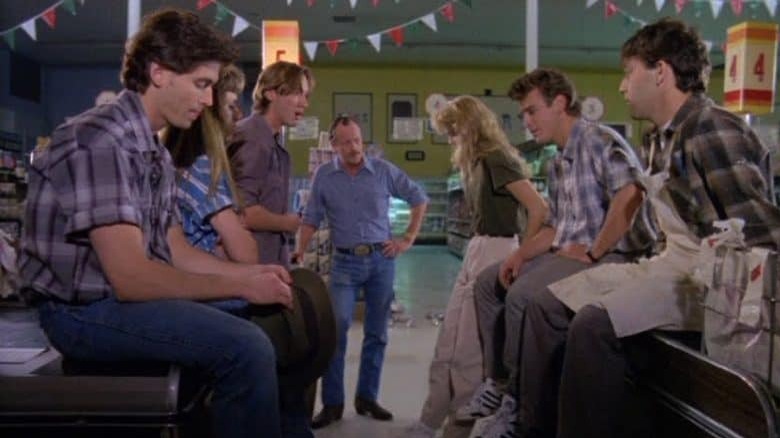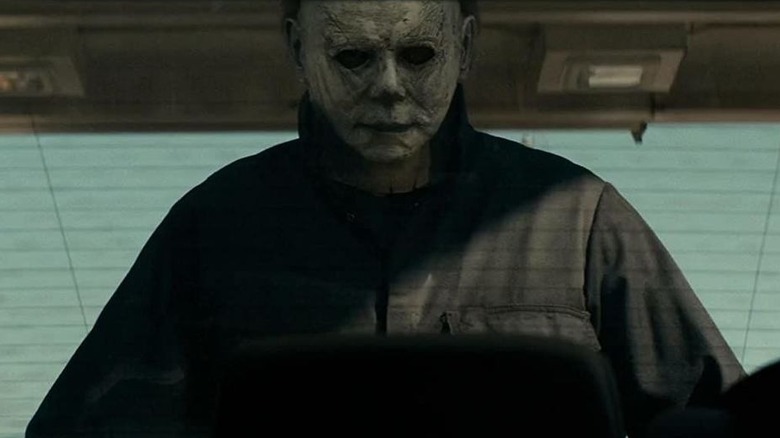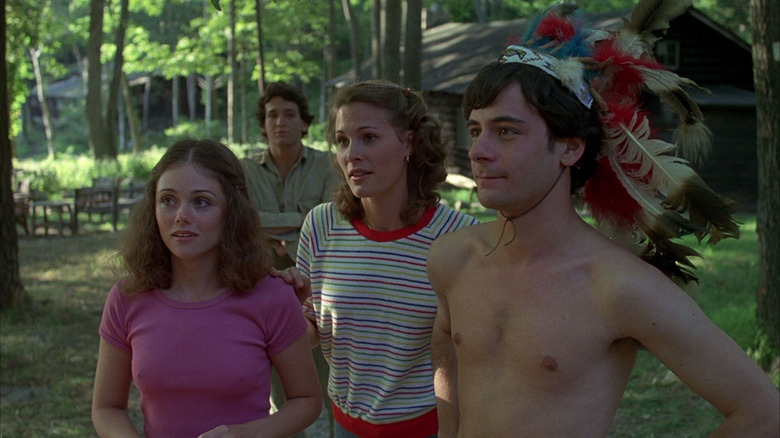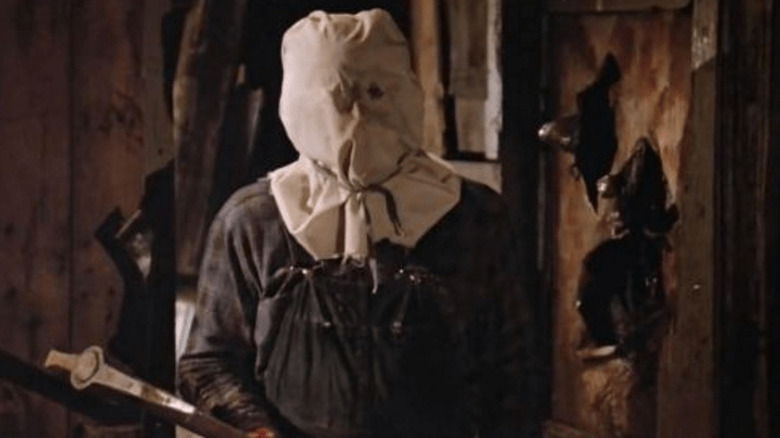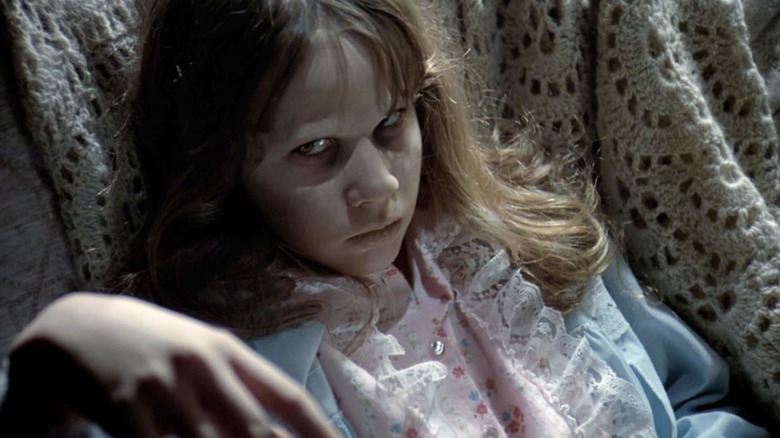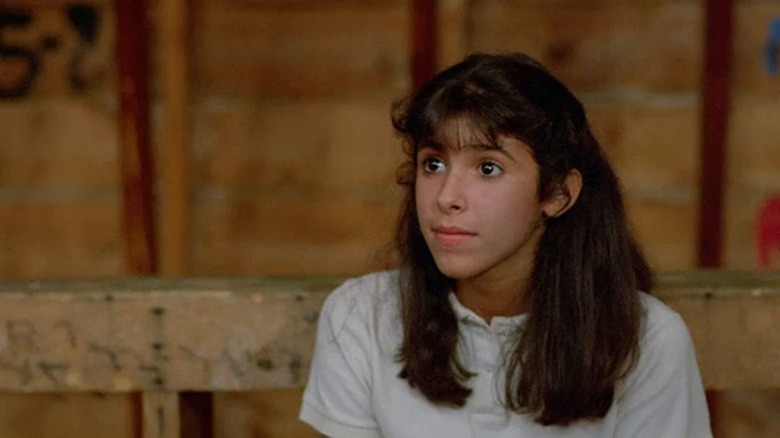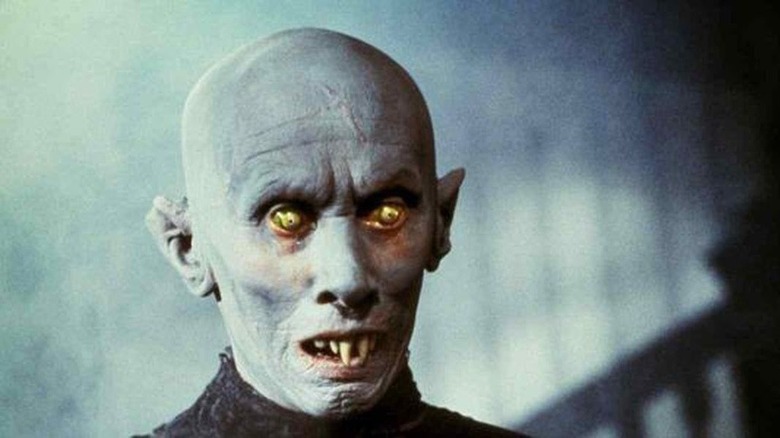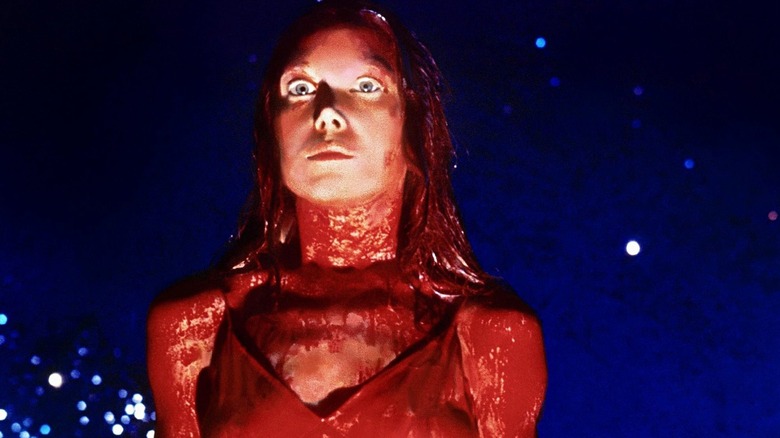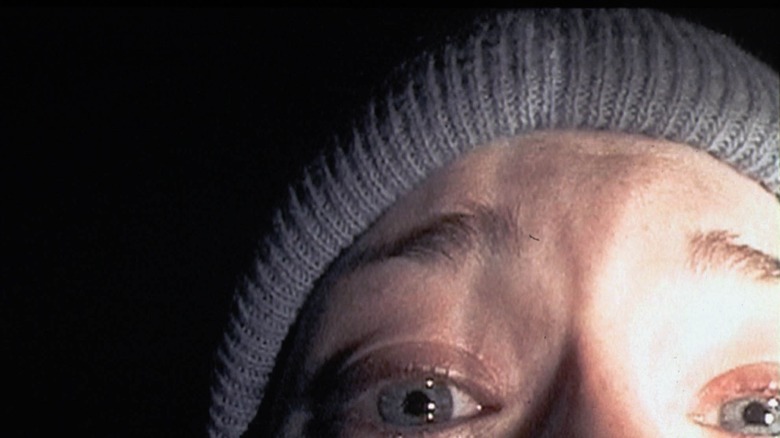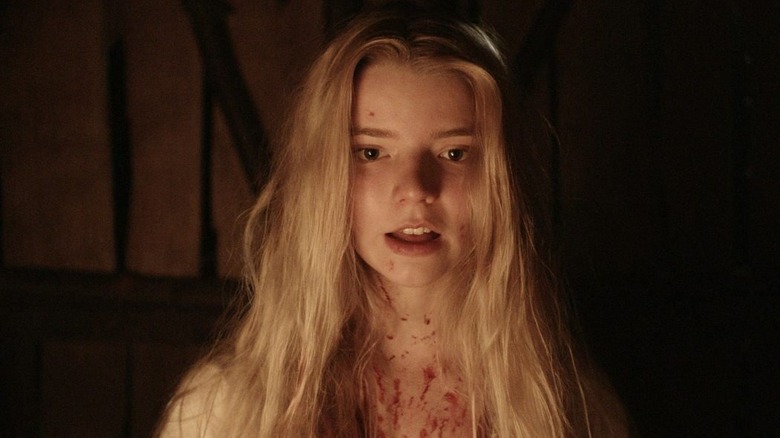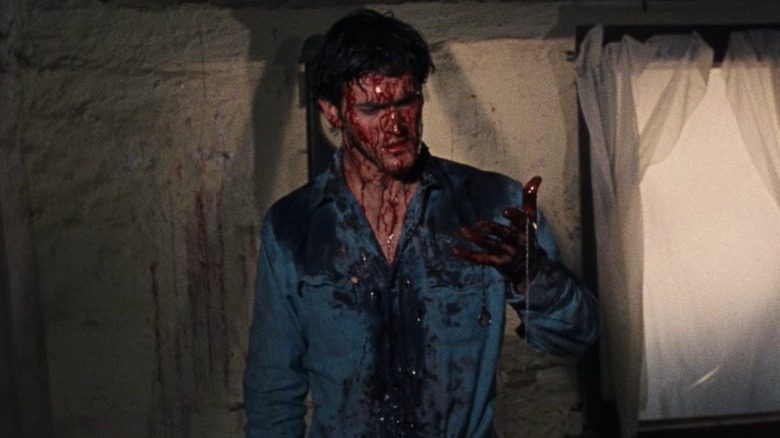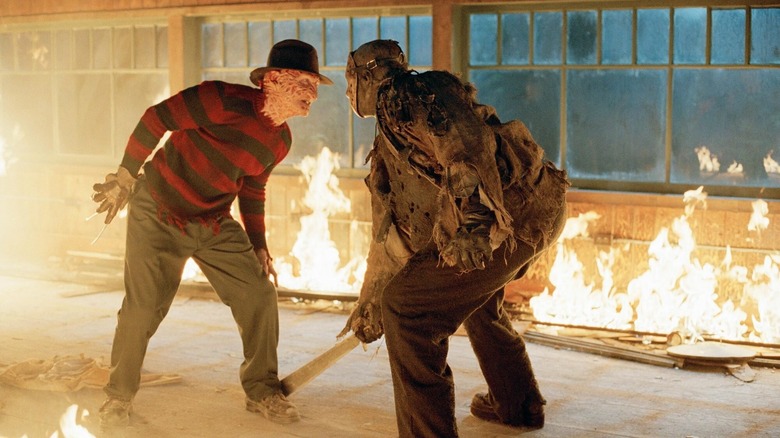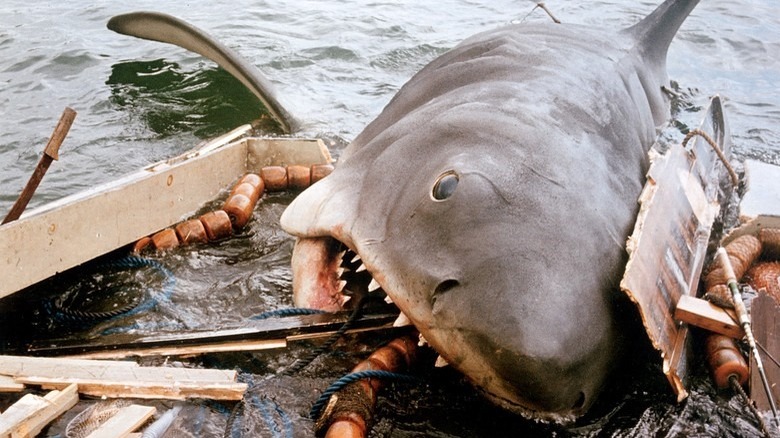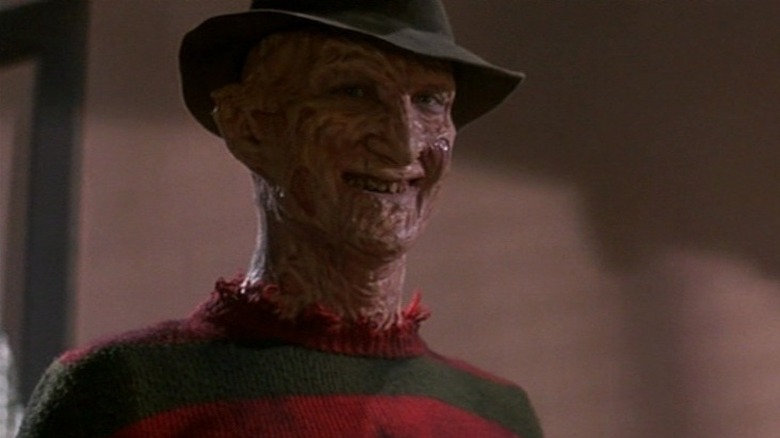All Of The Horror Movie References You Probably Missed In Fear Street
July ended up yielding an unseasonably good reason to break out the Halloween costumes in spite of the heat, especially for those who have Netflix subscriptions: the release of the entire "Fear Street" trilogy. Though the movies are an adaptation of the book series written by R. L. Stine, the films are certainly not aimed at the usual "Goosebumps" audience.
The films follow high schooler Deena as she tries to save her girlfriend Sam — as well a their entire town — from the witch Sarah Fier's curse, one said to have been hanging over its citizens for hundreds of years. But resolving a curse of that magnitude isn't easy; Deena and her friends must overcome the combined forces of the devil, Sarah Fier, and her cadre of gruesome, undead serial killers.
Featuring plenty of sex, drugs, cursing, and gobs upon gobs of blood and gore, these films seem tailor-made for teenage horror fans looking for some spooky summer fun. And it's not just the story or the films' tone that is meant to excite fans of slasher films; these films are practically overflowing with references to classic and even a few more obscure horror titles. While it can be fun to comb through every scene and every line, here's a little head start in finding all the horror movie references you probably missed in the "Fear Street" trilogy.
Scream
Featuring an unsuspecting teenage girl being stalked at night and chased down by a knife-wielding killer, the cold open of "Fear Street: 1994" seems anachronistically similar to a film that came out two years after the events of the film take place: Wes Craven's "Scream." So many elements of "Fear Street: 1994" line up beat-for-beat with "Scream" that the similarities are impossible to ignore. In both films, the female victim is alone at night when an unexpected phone call foreshadows the upcoming life-threatening terror the teenage soon-to-be victim is about to endure. Once the killer reveals themselves, a chase ensues, and just as the victim looks like she might get away, everything slows down as the killer plunges their knife into her in slow motion.
Aside from the sequence of events, the quick camera movements, and the high-energy editing, one of the most "Scream" seeming aspects about "Fear Street's" opening is the vibe given off by the film's score. A large part of that is due to the work of Marco Beltrami, who was half of the composing team behind the Netflix trilogy. Beltrami knows a thing or two about "Scream" himself, given that he was the composer of all four "Scream" films. Considering that "Fear Street: 1994" went as far as hiring one of the original "Scream" composers for the project, it's safe to say "Scream" has had quite a significant influence on the Netflix films.
The Shining
In "Fear Street: 1978," when Tommy Slater wields an ax, goes on a deranged murder spree, and is haunted by spirits that have lain dormant in the place where he's staying, the premise seems a little familiar. Granted, Tommy doesn't have a wife and son to terrorize, but there is a certain Jack Torrance air to his single-minded ax spree, and it seems that the filmmakers play up that angle.
The similarities to Jack Torrance — as well as "The Shining" in general — are highlighted by a couple of different shots from Tommy's rampage. The most overt reference can be seen in "Fear Street: 1994," when Tommy uses his ax to break down a classroom door that Deena and her friends have barricaded shut. This mirrors the famous scene when Jack hacks away at the bathroom door to reach his wife Wendy. Also in "Fear Street: 1978," a shot of Tommy as he marches about the grounds of Camp Nightwing looking for victims seems to mirror a similar shot of Jack Torrance as he stalks the halls of the Overlook Hotel.
Poltergeist
After being chased down by a teenager who had been shot in the head and another famous local butcher who had been dead for decades, Deena, Josh, Sam, Kate, and Simon deduce that the actual undead are pursuing them. And since it all started after Sam's vision of Sarah Fier, the group of friends ventures back to the site of Sam's vision only to find the still-chained bones of Sarah Fier herself. As they uncover the witch's skeleton, which lacks her infamously Satan-sacrificed hand, Simon throws out a potential explanation for why several undead murderers are violently pursuing the confused teens.
Simon posits that the haunting is due to Sam's car accident, which started on the road and ended practically on top of the shallow grave, and ultimately disturbed the bones of Sarah Fier. The solution, then? Un-disturb them, "Like in Poltergeist!" Simon exclaims as if having a grand epiphany. Referencing the film directly by name, Simon lifted this idea from the 1982 Tobe Hooper film where letting resting bones lie is the solution to a dangerous possession. In the film, it wasn't a car crash but a real estate development which disturbed the grave of a restless spirit. Though there aren't extra-dimensional pockets where any of the characters in "Fear Street" are trapped in, the teens eventually settle on trying to appease Sarah Fier's spirit in a similar way to the Freely family in "Poltergeist."
Night of the Living Dead and Dawn of the Dead
If someone says that they are being chased by the hostile undead, it wouldn't exactly be off base to envision slowly decaying, shambling corpses that have lost all human-like faculties. The reason that this specific description fits the cultural archetype of the zombie is largely due to the creative output of one man. With his 1968 film "Night of the Living Dead," George A. Romero cemented his vision of zombies into the cultural consciousness. Granted, other filmmakers, novelists, and artists have offered new interpretations of the undead, but Romero's insidious, walking corpses remain the most widely celebrated and referenced interpretation of the modern zombie.
Thus, when Deena and Sam talk with Sheriff Goode about being chased down by a masked killer who had already been killed by police, it comes as no surprise that Sheriff Goode responds with a cheeky reference to Romero's zombies. Mocking the two teens, Goode asks, "Were they more 'Night of the Living Dead?' Or more 'Dawn of the Dead?'"
Halloween
There are several different references to the famed "Halloween" films. During the vigil in "Fear Street: 1994," a sign reading "Goode Family Reality" can be seen in the background. This is most likely a reference to the "Strode Family Reality" signs littered throughout the "Halloween" series. Additionally, just like in "Halloween," Kate and Deena exchange a brief conversation on the phone before being attacked by the slasher. Laurie Strode places a call in "Halloween," checking in on her babysitter friend Annie just moments before Michael Myers murders her.
However, the most visually obvious homage paid to the elder slasher series is in the design of the milkman Shadyside killer. He uses a switchblade to stab his victims and routinely wears a blue jumpsuit, just like another seemingly unkillable spree-killing force of evil. Indeed, Harry Rooker's targeting of women may be a callback to Michael Myers's penchant for hunting down young women and turning into final girls, from Tina Willians to Jamie Lloyd to the inimitable Laurie Strode.
Intruder
The climax of "Fear Street: 1994" takes place in a supermarket where Simon works. The group of teenage friends tries to kill Sam in order to exploit a loophole in the curse of Sarah Fier. As the monsters converge on Sam to kill her once and for all, her friends each take on one of the killers in a desperate bid to buy more time. Ruby Lane, Tommy Slater, and Ryan Torres all attack at once, forcing each side to use the supermarket to their advantage. However, after Kate bumps into a bread slicer, Ryan Torres finally overpowers her and treats her head like a freshly baked loaf, cleaving it into several slices with the industrial carb cutter.
While the climax is incredibly gruesome and action packed, it may in fact be a reference to the 1989 slasher film "Intruder," which features a serial killer taking out supermarket employees at work. In the final moments of the film, the final girl wanders through the supermarket she works at after a serial killer coworker had gruesomely picked off everyone else on shift. Though the killer has to be fended off as he tries to stab his ultimate victim, Kate's death in particular seems like it may take influence from one of the more memorable kills from the film where a character's head is split apart by a table saw.
Halloween 2018
While there are visual references to "Halloween" in the design of the killer milkman Harry Rooker and other elements of the franchise's lore, there is one reference taken straight out of 2018's "Halloween." What sets this reference apart is that it is not found in character or setting but in a casting choice for "Fear Street: 1978." Having memorable roles in each film is actor Drew Scheid, who plays Oscar in "Halloween" and Camp Nightwing Counselor Gary in "Fear Street: 1978."
As Oscar, he secretly pines after Allyson Strode, awkwardly tries to kiss her after she breaks up with her boyfriend, and figuratively spills his heart to a watching Michael Myers right before Michael very literally stabs him in the heart. As a camp counselor, Gary is the cowardly foil to Nick Goode, who seems astoundingly calm and in control, as a murderer runs around the campgrounds killing whoever he crosses. Though Scheid plays two very different roles, considering the vast amount of homages "Fear Street" makes to the original "Halloween" film, Schied's inclusion just serves as yet another example of "Halloween" content that can be added in the "Fear Street" series.
Friday the 13th
The 1970s summer camp setting of "Fear Street: 1978" seems like an ideal place for a horror movie to let murderer loose. Being a part of the summer camp experience, parents are nowhere to be seen, letting kids and teens have a bit more autonomy — and opportunities to set their inhibitions aside. To boot, the natural surroundings of most camps, woods, lakes, and the abundance of different cabins and buildings to hide in, make for a riveting game of cat and mouse between camper and killer. That grouping of characteristics might help make Camp Nightwing an exciting setting, but it also doesn't hurt that one of the most popular slasher franchises already made killing campers and counselors alike a popular cinematic pastime.
Paying homage to its predecessors, Camp Nightwing seems highly reminiscent of Camp Crystal Lake — the infamous slaughtering ground of Jason Voorhees. But it's not just the camp's sign that seems familiar. One interesting parallel is the role of Nurse Lane in "Fear Street." Having a kid taken from you too soon and becoming obsessed with preventing that fate from happening again at any cost is a pretty specific character motivation, surely meant as a callback to original "Friday the 13th" antagonist Pamela Voorhees.
Friday the 13th: Part 2
There seems to be a reasonably direct inspiration for the look that Tommy Slater has when he tries to pursue Sam and then Deena in "Fear Street: 1994" and "Fear Street: 1666." Though he walks around Camp Night Wing during the year 1978 looking just like a teen with an ax, it's pretty safe to say that Tommy's bag-head look isn't just whatever the costume designer could find on the day of shooting.
Preferring a more classic ax murderer aesthetic, Tommy's slasher wardrobe seems to be directly inspired by Jason Voorhees' mask in "Friday the 13th: Part 2." The film features a hulking Jason who has yet to land on his iconic hockey mask look. He instead sports a burlap sack with small eye holes cut into the fabric. In addition to having similar, muscular frames, both killers appear to be wearing flannel patterned clothing during their respective killing sprees. What also helps highlight their similarities beyond clothing is that neither killer really talks as they kill campers. Without witty one-liners or psychotic repetition of a fixated phrase, both characters are only left a single avenue to communicate: their violence. This means that the two act similarly as they mow their victims down.
The Exorcist
Ziggy's reputation as a Shadyside delinquent doesn't help her make many friends. For example, Ziggy is ruthlessly bullied by other campers at Camp Nightwing to the point her assaulters trash the inside of her cabin. Among the insults scrawled on the walls are "Shadyside trash," "witch bitch," and "slut." However, when camp counselor Nick Goode enters her cabin, his attention is drawn to another colorful taunt: "Ziggy sucks c****s in Hell." (Though it's decidedly uncensored on screen.) This colorful phrase is a reference to the demon Pazuzu, or rather what a thoroughly possessed Regan, says in the 1973 horror phenomenon "The Exorcist." Though this abuse was hurled at Father Karass, who came to perform an exorcism on the unholy spirit, and was directed at the holy man's mother. Having a character say the quote aloud makes this reference a bit obvious; however, another, more subtle element of the series is reminiscent of "The Exorcist."
When characters get their blood on Sarah Fier's bones, they are afflicted with visions of the witch and her demise. Sprinkled into these montages are flashes of Sarah Fier's furious face taking up the entire frame. These brief flashes are reminiscent of the quick edits of Pazuzu's face that frightened audiences, some of whom believed that they may have been victims of subliminal demonic imagery.
Sleepaway Camp
"Sleepaway Camp" follows a thoroughly traumatized Angela as she spends her first summer away from home at Camp Arawak with her cousin Ricky. Due to her introverted behavior, Angela quickly becomes a target for bullies. One of Angela's fiercest bullies is a girl sharing her cabin, Judy, who becomes jealous when one of the boys develops a crush on Angela. In "Fear Street: 1978," Ziggy's camper nemesis Sheila seems to fill a very similar role to Judy. Both seem to inherently dislike their victims for arbitrary reasons and use their popularity at camp to enhance their bullying.
Another camper analog to "Sleepaway Camp" can be found in Jeremy, who ends up being the first camper to fall victim to Tommy Slater's ax. Though his counterpart doesn't meet such a grisly end, Mozart — the nerdy bullied kid at camp — fits a similar role to Jeremy in "Fear Street".
The Stand and Salem's Lot
One of the biggest surprises that young Ziggy faces in "Fear Street: 1978" is that Nick Goode, the son of the town's sheriff and poster boy of privileged Sunnyvalers, is also a fan of Stephen King books. After recognizing the plot of Stephen King's "Carrie," Ziggy asks about Nick's interest in King's works. In his reply, Nick says that "Carrie" is his second favorite next to "Salem's Lot." The book has its live-action adaption, which was released in 1979. Following a very similar plot to the book, Ben Mears returns to the town where he grew up — Salem's Lot, Maine — to write a book about a creepy, supposedly haunted house where Mears thought he saw an apparition in his youth. However, a pair of businessmen who are secretly a vampire and his familiar buy the house and intend to use it as a furniture shop. In the end, most of the town of Salem's Lot are turned into vampires themselves, and Ben Mears must again flee to find a non-supernatural refuge.
As Ziggy and Nick carry on their conversation after they dump a bucket of bugs on Ziggy's bully, Nick muses that King's "new one is supposed to be good." This likely refers to "The Stand," a 1978 story of how an respiratory viral pandemic kills most of the world's population and how the survivors fight with each other. "The Stand" would also go on to have a mini-series in 1994.
Carrie
Of the many Stephen King references, the allusions to "Carrie" are probably the most prevalent in the "Fear Street" films. In "Fear Street: 1978," camp counselor Nick Goode checks in on Ziggy as she prepares her revenge on the girls who vandalized her bunk. He sees her seething on her bunk as she mixes red paint with water in a bucket. When asked about the paint, Ziggy replies that she didn't have any pigs blood around, and Nick replies, "'Carrie.' Cool." As Nick himself expresses, the reference to pouring porcine blood on someone from an overhead bucket directly references the plot of Stephen King's "Carrie," in which a psychic outcast has a bucket of pig's blood dumped on her by a gaggle of bullies. After hinting that he has a better plan, Nick tells Ziggy to "'Carrie' on," but even though the pair ditch the paint, this scene isn't the last time Nick or Ziggy references the Stephen King story.
Leading up to the climax of "Fear Street: 1666," an adult Ziggy lays out a plan for how to take down Sheriff Nick Goode, saying, "We'll 'Carrie' him." Done dealing with paint, Deena's diluted blood is stashed in a bucket that is dumped on Sheriff Goode in an effort to get the Shadyside murderers to target him.
The Blair Witch Project
In "Fear Street: 1978," Cindy and a couple of other counselors break into the infirmary at Camp Nighthawk after Nurse Mary Lane tries to murder Tommy. The group comes upon a journal among Nurse Lane's belongings that seems to describe where to find things related to Sarah Fier. The group of four intrepid teens then journey into the woods at night in search of Sarah Fier.
This scenario pretty closely mirrors the plot of "The Blair Witch Project," where a group of college students makes two documentaries as they journey into the woods searching for the local legend: the Blair Witch. The journey into the Maryland woods ends about as well for the documentarians as it does for the group of camp counselors, unfortunately.
Another subtle connection to "The Blair Witch Project" can be seen inside of Sarah Fier's house in "Fear Street: 1666." Hanging on the Fier family wall is a small, stick man figure, a piece which bears a striking resemblance to the wooden figures which appeared as the Blair Witch grew nearer and more active.
The Witch
The setting of the final entry in this Netflix trilogy is mainly in Union, the 17th century settlement which eventually develops into the Shadyside and Sunnyvale featured in the preceding two films. The plot follows Sarah Fier as she falls in love with another woman from Union and is subsequently labeled a witch. Knowing that what she has done can never be forgiven by the people of Union, Sarah endeavors to give them the witch they so desperately crave and admits to making a pact with the devil. A summary execution follows, but not before Sarah enacts her own retributive curse.
The story of Sarah Fier's sexist persecution and alleged dalliance with the devil mirrors the broad narrative strokes and setting of Robbert Eggers' 2015 film "The Witch," which takes place in 1630s New England amid a pious agrarian family. The daughter, Thomasin, is falsely accused of being a witch by her family, but not long after the abuse starts, the devil — taking the shape of the family's black goat — kills them all and invites Thomasin to write her name in his book. Just like Sarah Fier, who could no longer rely on anyone close to her, Thomasin ends the film by embracing her newfound witchiness.
The Evil Dead
The most essential object to the story of "Fear Street" films is introduced in "Fear Street: 1666." As Sarah Fier and her friends try to escape the puritanical drudgery of life in Union, they seek the assistance of a widow who lives by herself in the woods. There, she has a stockpile of berries that Sarah and her friends use to get high and party by the light of a fire in the woods. While her friends are off looking for the stash, Sarah happens upon an important-looking book that has beguiling images carefully drawn inside. More intriguing is that the page Sarah opens to contains instructions on how to make a deal with the devil, clearly the most taboo of taboo things she could have seen. Sarah is advised by the widow to beware the book because "the devil lives in it."
This sketchy book seems incredibly similar to the Necronomicon, or Naturom Demonto, from the "Evil Dead" franchise. An incantation read from the Book of the Dead is all it takes to invite demonic forces into the world and to possess those present, turning them into deadites. Just like the incantation recorded on an old audiotape that set off the possessions of Ash's friends, calling out the names of the devil begins the bargain that shapes the fate of Union, its residents, and their descendants for centuries to come.
Freddy vs. Jason
When fans are given a set of undefeated fighters spanning different series or franchises, it's easy to imagine them going up against each other to determine which combatant would take the crown in a final showdown. Fans of a given franchise can always make the character equivalent of the "My dad could beat up your dad," line of argumentation, but there is very rarely anything canonical and really to back that up.
Fans got their wish in 2003 with "Freddy Vs. Jason," a film exploring what would happen if the stalker of summer camps and the stalker of dreams were to face off. It is this type of dynamic that is evoked in "Fear Street: 1666" when Deena's blood is splashed on various Shadyside killers all at once. While other films like the "Alien vs. Predator" series or 2016's "Sadako vs. Kayako" share a similar premise to "Freddy vs. Jason," the slasher-on-slasher violence of "Freddy vs. Jason" seems to be a slightly more fitting parallel than the other two films.
Jaws
After Deena, Sam, Kate, Simon, and Josh figure out that the undead Shadyside killers are not after them as a unit but are instead attracted to Sam's blood, they formulate a plan to trap and take care of these undead creeps once and for all. The goal is pretty simple: Lure the killers into one room, fill it with flammables and explosives ahead of time, lock the killers in, and light them up. As they prep their improvised explosives, Simon excitedly says, "Smile, you son of a bitch!"
What he's referencing is the final line in "Jaws." It's spoken by Sheriff Martin Brody before he shoots an oxygen tank in the gargantuan shark's mouth, which explodes into a red pool of blood and seemingly finishing off the fish for good. The hope is that this firebombing will be enough to rid the group of their trio of killers. Just like the shark, the antagonists explode into a liquidy mess — but unlike any shark known to man, the post-explosion mess reforms into its original shape and continues its undead murder mission.
A Nightmare on Elm Street
By virtue of his powers to invade the dreams of his victims, Freddy Krueger handily became one of the most terrifying characters in the slasher subgenre. Even though his striped shirt, battered brown hat, his burned skin, and his deadly knife gloves all combine to give him an iconic look, one of Freddy's most recognizable tactics is how he employs terror upon his victims. A common omen of Freddy's imminent attacks is a little ditty that is first sung by creepy little girls in the original "A Nightmare on Elm Street." The song signals both to his impending victims and to audiences that Freddy's appearance is imminent, literally saying, "One, two, Freddy's coming for you. Three, four, better lock your door..." It seems like the creators of "Fear Street" wanted to achieve a similar effect with their killer Ruby Lane, who sings as she targets her prey.
Ruby's discomforting song is actually a creepy rendition on "You Always Hurt the One You Love," first recorded in 1944 by The Mills Brothers. Ruby's old-timey song is enough to lull Simon into a false sense of security as he checks on her, thinking that she may require help. What she doesn't share with Freddy in aesthetics, she certainly does in tenacity, coming back again and again to kill Deena and her friends, just like Freddy kept coming back for sequel after sequel.
